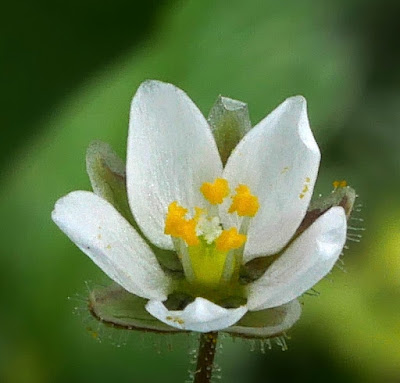Mid month and I decided to re-visit Pentire Farm, a National Trust managed farm near Newquay known for its good selection of arable plants. I had briefly been there during the summer, but the lack of rain and drought had meant there wasn't much to be seen at that time. However, the recent rain had brought the place to life. Here's some of the more unusual plants I found there.
Corn Marigold is mostly only found as a bird seed casual in much of the UK, but it is native in Cornwall and this was a stronghold area. In places there were hundreds of flowering plants.
Glebionis segetum
Dotted around the field were a few specks of pale blue belonging to Pale Flax, another Cornwall native. I had also found this in the Camel Estuary dune systems in June.
Linum bienne
One of the plants I had hoped to find was in one field in good numbers, Weasel's Snout, a small snapdragon that is quite rare in much of the UK.
Misopates orontium
Dotted around the field were several Wild Radishes, most with lilac coloured flowers, but a few were white too. Nearby, on the cliffs was the yellow Sea Radish but that wasn't in flower.
Raphanus raphanistrum
Corn Spurrey was also present in the fields.
Spergula arvensis
The fields were enclosed with Cornish walls, a mixture of slate, rocks and earth. These walls support a myriad of plants, but being so close to the sea, Rock Sea-Spurry was dominant.
Spergularia rupicola
My final offering from these special arable fields was Field Woundwort.
Stachys arvensis
In coastal areas (and some salted roads inland), one can find the more unusual sub species of Great Plantain. These are much smaller than the usual form, with small 3 veined leaves on a longer cuneate shaped stem. The flowerheads are small and very dense too.
Plantago major subspecies intermedia
On a recording walk around Park Head on the north coast, I found this odd looking Orache. The commonest two species found here are Spear-leaved and Babbington's Oraches, but this was different to either of them. It was fleshy green with some leaves near the stem tips and a few bracteoles were stalked. An email to the BSBI Atriplex referee followed and he determined this was the hybrid between Babbibgton's and Long-stalked Orache, an unusual and nice find.
Taschereau's Orache
Atriplex x taschereaui (A. glabriuscula x longipes).
The bracteoles were spongy at the base with a few teeth and no tubercules on the sides (Babbington's has tubercules). It was also only open to less than half way. These features ruled out Spear-leaved Orache.
The seeds had the radicle ( the point where the seed would sprout) sub basal and pointing laterally, a feature of Long-stalked Orache.
I now look very closely at any coastal Atriplex species I come across. Most are the parent plants of A. prostrata or A. glabruiscula. The other potential parent is A. longipes which is very rare in Cornwall.
Up until this point in time, I had only found Autumn Squill in seed. The drought conditions had caused most to flower and seed within a week, so I missed most of them. Inspired to look again from some finds shown on Twitter, I finally found two plants still in flower near Ephaven Cove on the north coast again. What delightful little flowers they are too. They look like miniature Spanish Bluebells, unsurprising, given they are related. However, unlike those, these are native plants and can mostly be found on western coastlines in short turf.
Scilla autumnalis
The photo below has a coin included to show some scale. Small aren't they!
On a brief visit to Par Sands on the south coast, I found numerous Evening Primroses in flower. Earlier in the Summer, the place was full of Large-flowered Evening Primrose, but the shape of the petioles (flower stems) and the smaller flowers with styles not exceeding the anthers meant the current plants were a different species. These can be tricky to identify and there is a BSBI handbook on them, as they hybridise freely making some identifications difficult. However, these were easy to identify as they were also scented. I give you the Scented Evening Primrose.
Oenothera stricta
Nearby were the biggest stands of Prickly Saltwort I had ever seen. It does very well here, though it's now in seed. They are very prickly, so don't sit on any! On the highest tides, the seeds will float off and disperse to other beaches.
Salsola kali
In amongst the Prickly Saltwort were numerous plants of Sea Knotgrass. These are quite rare and are characterised by the large (compared to other knotgrasses) flowers being tightly bunched and they also have inrolled leaves which you can see in the photo below.
Polygonum maritimum
I finished off the month with a woodland walk where I found plenty of Bifid Hemp-nettle with their attractive, though fairly small flowers.
Galeopsis bifida
Hawkweeds are similar to Dandelions in that there are numerous micro species that self clone. It's an area I haven't yet explored, but one usually finds a few in hedgerows and walls at this time of the year.
Hieracium
As September ended, the rains arrived in earnest and so had the wind. Over the next few months, I hope that our reservoirs and lakes will be refilled and the drought broken, although despite several inches of rain lately, the main water reservoir at Colliford is still below 25% full, so there is a long way to go before the drought restrictions can be lifted.
Until next time take care.
Dave
@Botany2021

























No comments:
Post a Comment
All comments are moderated before publication, so please don't bother spamming me, thank you. Genuine comments most welcome.